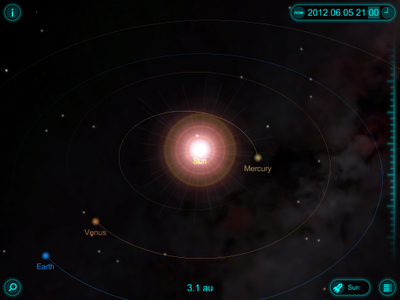Venus Transits the Sun
 |
Tiny Venus transits the Sun at 9PM eastern time on my NASA TV App. I was here.
|
The days leading up to the transit prompted some interesting conversations with my fellow space geeks about whether a telescope makes astronomy any more "immediate" and meaningful than watching it on my iPad. Sacrilege to some. Of course, viewing space through a telescope as opposed to a video stream is the difference between seeing Mount McKinley in person and watching it on a web cam. I get all that. But, for some reason, I don't consider I am missing out on anything where space software and apps is concerned.
Before my iPad I used Starry Night on my PC regularly to view the night sky. I could jump into the future and figure out when the International Space Station or some satellite would venture over my house and on clear nights I would go out at the appointed time to follow the object in my binoculars. That seemed entertaining.
I guess it is a slippery slope. Now, I prefer to just watch events on my various apps: Star Chart, Solar Walk, and Star Walk. There is so much you can do with these apps that allows you to manipulate the cosmic moment, going forward or backward in time, knowing what a faint star is literally at the touch of the screen, being able to choose different angles to view things. I'm sure I seem lazy to the weekend Star-hopper groups who stay up all night on a hillside somewhere with their hot chocolate. But, to me, I am still experiencing the universe in a way that gives me a sense of wonder.
So it is with iPad in hand and with the NASA TV app playing that I witnessed the transit of Venus. I have no solar filter for my Celestron telescope so I saw everything over the Internet. I did not feel the moment was trivialized or rendered artificial in any way.
Venus and Earth are now at their closest proximity - about 26.9 million miles apart. Of course, Earth remains more or less 93 million miles from the Sun. The distances involved and being able to see and experience the distance is one of the most rewarding aspects of astronomy for me. I know that when I saw the silhouette of Venus today against the bright Sun I am literally looking across about 27 million miles of space. I appreciate that regardless of whether I am looking through optical or digital devices.
I didn't realize until today (although it becomes obvious if you pay attention to solar modeling featured in software like Solar Walk) that Venus actually moves between the Earth and the Sun 5 times every 8 years. But the inclination of the orbits in three-dimensional space generally prohibits a transit event. This same inclination issue is the reason why we don't have more solar eclipses...the Moon doesn't usually line up just right between the Sun and the Earth.
It might seem that we are uber-lucky, given that the next one isn't for 105 more years, to get a transit event just eight years after the last one in 2004. But, in truth, it is always like this. Since the telescope was invented, Venus transits have been observed in 1631, 1639, 1761, 1769, 1874, 1882, and 2004. See a pattern? Alternating every 122 or 105 years Venus transits the Sun as seen from Earth. When it thusly transits the Sun it does so twice within 8 years. All thanks to the clockwork of planetary orbits.
Eight years ago I watched the event on the Internet, just as I did today (though it was on my PC then, not my wonderful iPad). It was the opposite of today's transit. Back then, the transit in the US was during sunrise, not sunset. (I wonder if that alternates each time as well?) My view was blocked then by the hill to the east of my house. Of course, I could have planned to view it from a more opportune location. Nothing prevented me other than the fact it was a workday and I probably had some meetings and projects scheduled.
The Internet allowed me to fit that into my day without taking vacation. This did not diminish the event at all for me, anymore than it did today. I know I will likely never see this again. The fact that this last transit is an iPad-driven experience for me actually makes it more special, not less. Technology is giving me an opportunity that I would otherwise miss. Plus in Solar Walk I can replay the event. In truth, I checked the whole thing out last week anyway. Just to see how it would look.
 |
Another angle of the same alignment at the same time. This is from 5 AU and includes Mars, Jupiter, and part of the Asteroid Belt.
|
The Now does not have to be chained to time and place. Today more than ever, taking pleasure in the transit of Venus is a state of mind.
Note: Of course, by the next day there were all kinds of great images and videos of the transit available on the web. Here is the best one I saw. Pretty incredible.


Comments